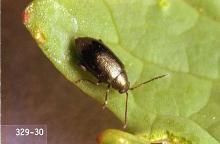Includes cabbage flea beetle (Phyllotreta cruciferae)
Pest description, crop damage and life history
See:
Common Pests of Vegetable Crops
Biology and life history Most flea beetle species have similar life cycles. Adults overwinter in trash around field margins. They become active in late March through May. Flea beetles lay their very small eggs in May in the soil around the plant, on the leaves, or in cavities hollowed out in stems. The larvae feed on the foliage, mine the leaves, or attack the roots, depending on the species, usually from June to mid July, when pupation in the soil occurs. Adults emerge from July through early September and feed a short time before overwintering in trash around field margins. Depending on the species, there are one or two generations each year.
Pest monitoring Monitor fields for flea beetles soon after transplanting or as seedlings emerge. Flea beetles attacking the cotyledons of emerging broccoli seedlings can destroy a new planting in 24 hours. Treat for flea beetles when small holes show on transplants or on plants from seeded fields. Young plants (three to five leaves) often withstand flea beetle injury, but they may be killed if the weather is dry and windy. The percentage of plants affected and forecasted weather conditions will indicate the need to treat.
When the flea beetles on seedlings are migrating from hosts outside of the field, most of the infestation will be localized within 200 feet of field borders. Check the distribution of leaf feeding to see if this is the case, and consider border treatments only. If high populations exist 1 to 2 weeks before harvest, and foliage is declining as a food source for the beetles, spot treat according to the flea beetle distribution.
Management-cultural control
"Trap crops" such as radish or daikon may help lure flea beetles away from the main crop. This has not been tested in the Pacific Northwest. Floating row covers or other screening can be used to exclude the beetles during seedling establishment of high-value crops. Flea beetles can be vacuumed off foliage, but this must be repeated frequently. Reinvasion of plants can be rapid.
Management-chemical control: HOME USE
- azadirachtin (as a mix with pyrethrins)-Some formulations are OMRI-listed for organic use.
- imidacloprid
- kaolin-Applied as a spray to foliage, It acts as a repellent to some insect pests. Some formulations are OMRI-listed for organic use.
- malathion
- pyrethrins-Some formulations are OMRI-listed for organic use.
Management-chemical control: COMMERCIAL USE
- dinotefuran (Dinotefuran 20SG, Scorpion 35SG) at 0.09 to 0.18 lb ai/A. PHI 1 day. REI 12 hr. Retreatment interval 7 days. Do not exceed 0.36 lb ai/A per season.
- malathion (Malathion 8) at 1 lb ai/A. PHI 7 days. REI 12 hr. Retreatment interval 3 days. Limit 5 treatments.


